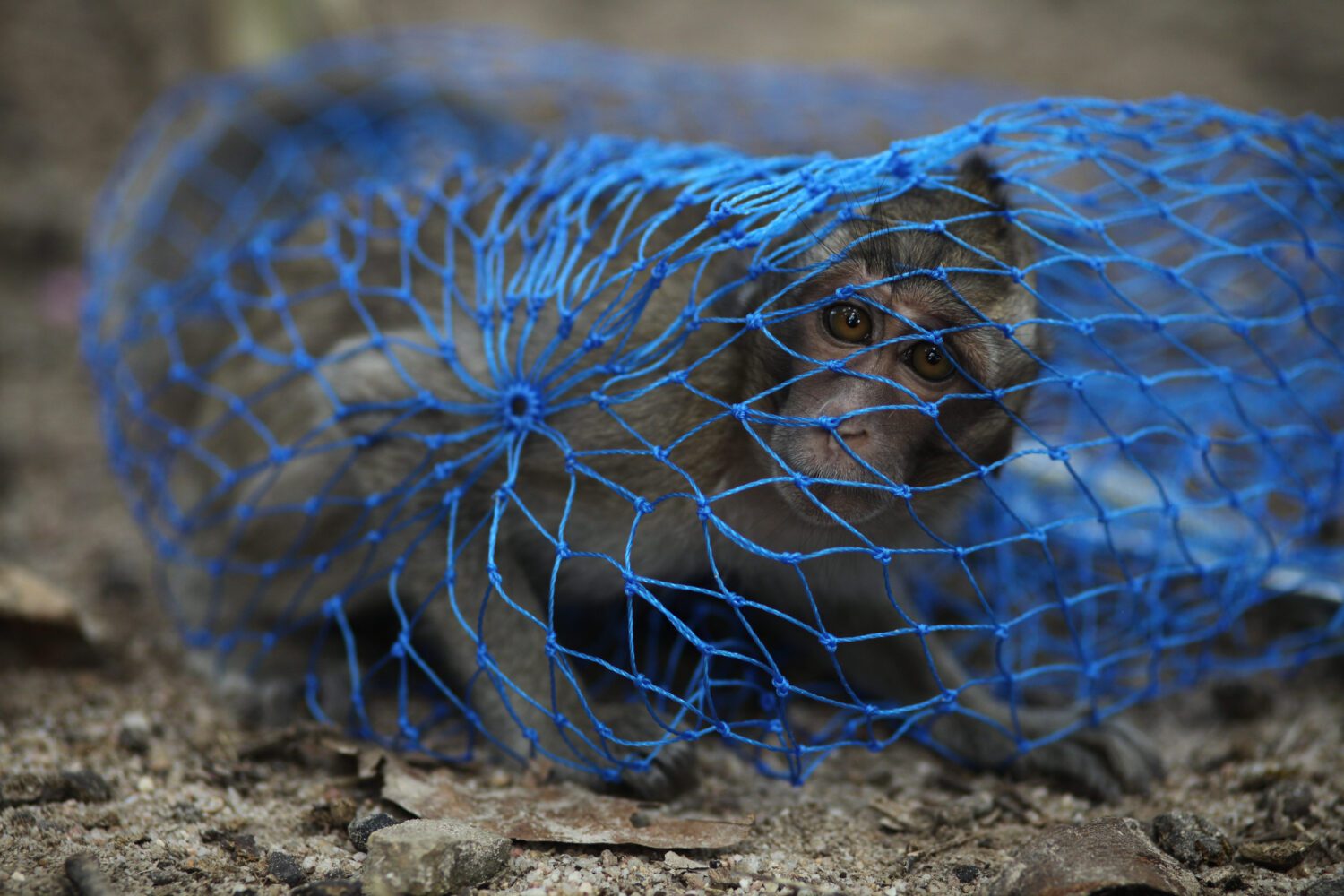Monkeys Infected With Transmissible Diseases Are Trucked Across U.S.
May 17, 2022
Experimenting on monkeys is cruel—and keeping them is a threat to public health.
By Lisa Jones-Engel, Independent Media Institute
...
Members of the genus Macaca, with their unsurpassed ability to inhabit the edges that humans create when we alter the environment, are the most geographically diverse and successful nonhuman primate group in the world. Multiple species of macaques are naturally distributed throughout Asia; in addition, northern Africa is home to a single species known as Barbary macaques, and macaques have also managed to successfully colonize Mauritius and Florida.
However, there are three species of macaques—long-tailed, rhesus and pigtailed—that have been relentlessly targeted by the primate biomedical research community. It is ironic that macaques’ extraordinary ecological and behavioral flexibility has made them more visible and cost them their lives, with countries like the U.S. increasingly using them for experiments in the name of making advances in biomedical research. According to the Convention on International Trade in Endangered Species of Wild Fauna and Flora (CITES) database, more than 1.5 million long-tailed, rhesus and pigtailed macaques have been exported from Asia and Mauritius to laboratories around the world since 1975.
These monkeys have been relentlessly trapped in urban and semi-urban areas. They’ve been grabbed as their sleeping trees were cut down and netted as they tried to swim away. Entire troops have been captured after being isolated in the one tree that remained in a crop field. Untold numbers of adult macaques have been beaten to death as they tried desperately to hold onto their infants or protect their friends while they were being captured to be used for experimentation. More deaths followed as they were stuffed into rice sacks, wire bags or wooden boxes after they were captured.
The 1.5 million macaques exported were the “survivors” of this ordeal. The actual number of macaques extracted from Asia and Mauritius is much larger; captive-born and wild-born macaques form the “breeding stock” on the “monkey farms” of Asia and Mauritius. The stress of capture, the horrific conditions in which the macaques are kept in after their capture, and the exposure to pathogens while in captivity have led to many of them dying from disease. These monkeys are then “replaced” with more wild-caught macaques.
The recent images from the accident in Danville, Pennsylvania, of the cramped, airless, wooden crates containing macaques who had traveled nearly 10,000 miles from Mauritius have blown the lid off this cruel, secretive, greedy and dangerous industry. The crash was so violent that some crates burst open and three monkeys escaped into the surrounding area. Representatives from the Centers for Disease Control and Prevention (CDC) did a risk assessment and decided that the three escaped macaques be shot on sight.
News coverage of the situation spread around the world. People wanted to know where the monkeys had come from, where they were going, if they carried diseases, and if there was anything to fear. The lack of transparency from the CDC about the status of the surviving monkeys or even the location of the CDC-approved quarantine facility to which they were headed is disturbing. The agency reported that between October 2019 and January 2021, more than 70,000 macaques were imported into the United States. These monkeys arrived by plane in more than 300 shipments. From the port of entry, they would have been loaded into trucks and sent to the approved quarantine sites to begin a mandatory 31 days of isolation, testing and observation.
The CDC quarantine is designed to protect public health by detecting monkeys who arrive with viral hemorrhagic fevers, tuberculosis, pathogens that can cause deadly diarrheal diseases, fatal diseases transmitted by mosquitoes and herpes B, a zoonotic macaque virus. Not all the monkeys make it out of quarantine alive, andthese dangerous pathogens that the CDC is screening for are often missed and show up months or years later threatening public health and further undermining the utility of these monkeys as biomedical models. Post-quarantine, the surviving monkeys are dispersed to commercial facilities and laboratories around the country.
Certificates of veterinary inspection (CVIs) obtained through the Freedom of Information Act requests that PETA submitted to agriculture departments in numerous states give a further glimpse into the extent of monkey transport across the United States. CVIs are required by the U.S. Department of Agriculture when monkeys are transported across state lines. PETA has pieced together a monkey transport map with the help of data that my organization [the author is a senior science adviser on primate experimentation with PETA’s Laboratory Investigations Department] has gleaned. Each line drawn on the map represents the journey of the monkeys from the lab, breeder or importer that sold these monkeys to the facility that purchased them. There are many more routes that we have yet to uncover, and many of them have been used multiple times, sometimes dozens, since 2018.
Pause for a moment and consider the magnitude and cost of this monkey madness: In January, the disaster involving the truck transporting monkeys took place in Danville, next month, it could be in your community. No one is safe—the monkeys are on the move the moment they arrive in the United States. Packed into small wooden crates, separated from their family and friends, they’re terrified, cold and hungry. In this vulnerable and stressed condition, they are likely immunocompromised, which increases the risk that they will shed pathogens that can cause diseases in humans. Even the experimenters themselves have acknowledged that the large colonies of monkeys at their facilities—in places such as Texas, Florida, Louisiana, Georgia, North Carolina and California—are a threat to public health...
___________________________________________
See also:
PA - Danville woman concerned for her health after coming face-to-face with monkey following crash
Georgia deputies called to capture 'monkeys on the loose' - origin unkown
